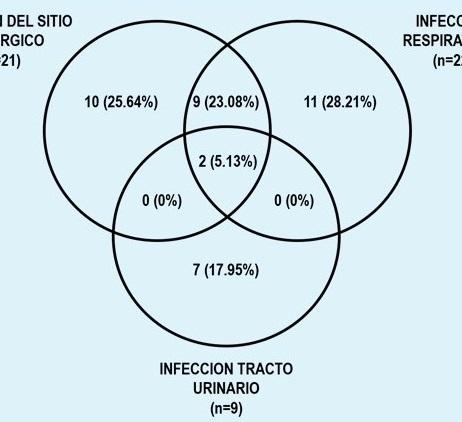Usted está aquí
Peruvian Journal of Neurosurgery
Nosocomial infections in neurosurgery: a study of incidence, associated factors and etiology. Cayetano Heredia Hospital. April 2020 - March 2021
ELDER CASTRO C., ROMULO RODRIGUEZ C.
Abstract (Spanish) ||
Full Text ||
PDF (Spanish)
ABSTRACT
Objectives: To determine the incidence, associated factors, and etiology of nosocomial infections (NI) in patients hospitalized in a neurosurgery service.
Methods: Descriptive, retrospective, and cross-sectional study in patients 18 years of age and older, hospitalized in the Neurosurgery Service of Hospital Cayetano Heredia (HCH), between April 2020 and March 2021. Data were collected from medical records, registry care diary, and the HCH laboratory computer system.
Results: Of the total number of patients (n=116), the male sex (73.28%) and the age between 18 to 59 years (73.28%) predominated. 35.34% had at least one NI, being the most common pneumonia (18.97%) and surgical site infections (SSI) 18.10%. NI were associated with traumatic brain injury (TBI) (p=0.005), spinal cord trauma (SCI) (p=0.020), surgery (p=0.032), stay in Intensive Care Units (ICU) (p=0.000), hospital stay greater than seven days (p=0.000) and mortality (p=0.049). Pneumonia was associated with all the above factors, except trauma and surgery; while SSIs were associated with these factors except for SCI, the performance of surgery, and mortality. Gram-negative agents and enterobacteria were the most frequent in SSIs (72.73%) and pneumonia (94.74%).
Conclusions: NIs occurred in a third of the patients; increasing in those with traumatic pathology, undergoing surgery, admitted to the ICU, and prolonged hospital stay; thereby increasing mortality. It is unavoidable to consider the presence of Gram-negatives and enterobacteria when using antimicrobials in the treatment of NI in neurosurgical patients.
Keywords: Pneumonia, Surgical Wound Infection, Neurosurgery, Brain Injuries, Traumatic (Source: MeSH NLM)



